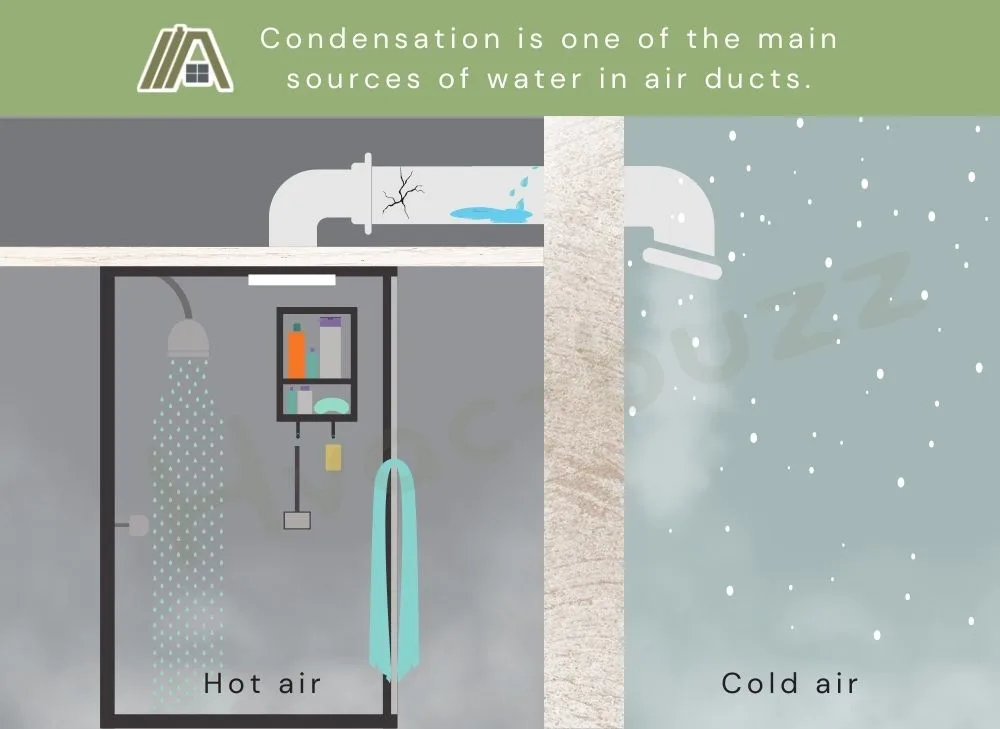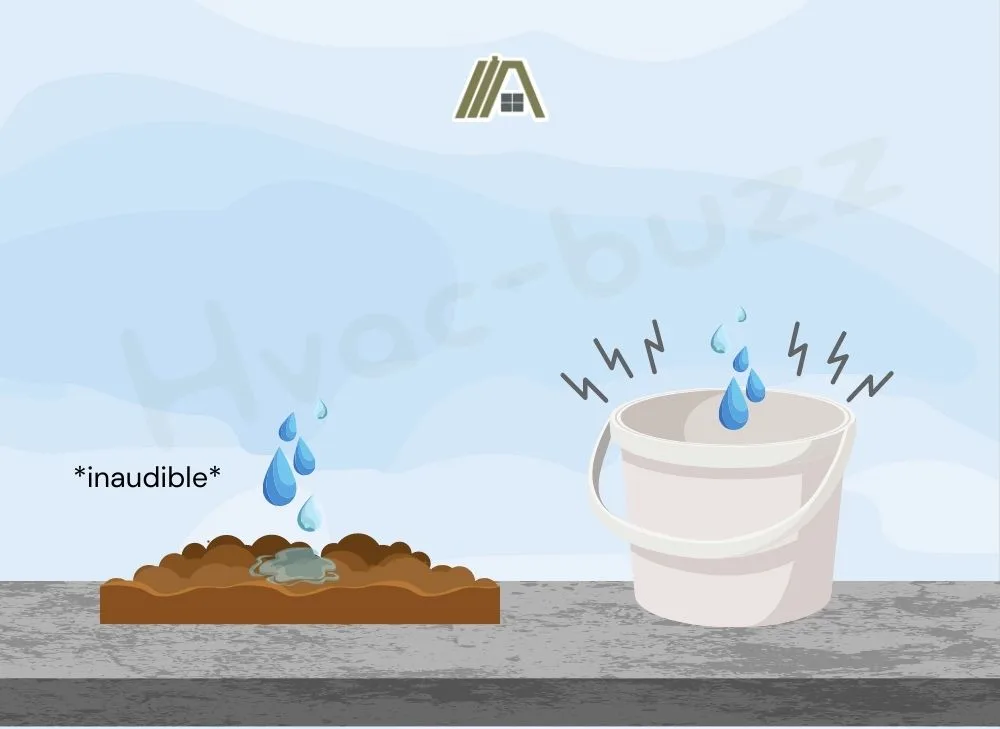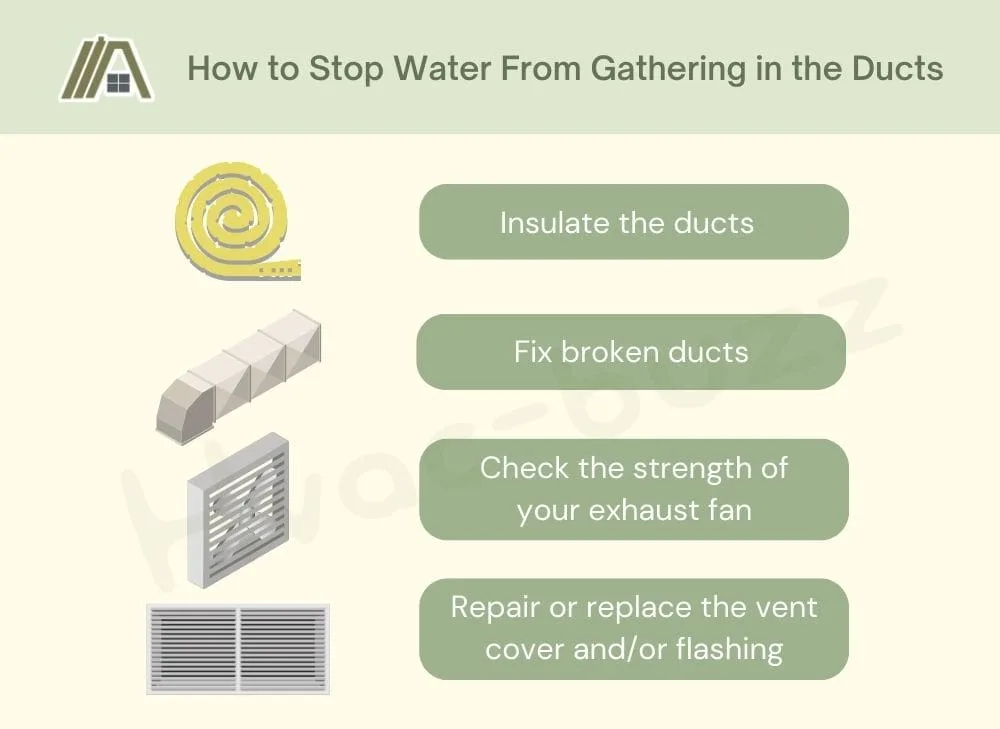It can be one of the most annoying things to hear a dripping noise and not know where it’s coming from. But finding the source of the noise is not enough to allow us to fall asleep again, carry on reading our book, or do whatever we were doing before the drip became too much to handle. We also need the drip to stop.
Figuring out why the bathroom fan is emitting a dripping noise is the first step to eliminating this annoying sound.

Condensation, snow, and rain can form in or enter bathroom fan ducts. The water drips because of the ducting angles. Insulation, duct repair, fan upgrades, and roof vent/flashing repair can stop the dripping. Pipes and roof leaks can drip on the outside of the duct. Repairing these leaks will stop the noise.
Sources of Water in Bathroom Ducts
Condensation is one of the main sources of water in air ducts. When the hot, steamy bathroom air comes into contact with cold ducts, the air cools down and water condenses out. This is more likely to happen or to be more pronounced if the ducts are uninsulated and in cold weather.

When there are cracks in the bathroom duct system, cold air can enter the ducts when the fan is off. Then, when the fan is operating, the air entering the ducts comes into contact with this cold air, and heat is transferred (shared among more air molecules). The overall air temperature in the ducts decreases and water condenses out when the temperature drops below the dew point.
There is another way that cracked ducts can result in condensation and this is via the loss of exhausted air through these cracks. When the volume of air inside the ducts decreases, it reduces the rate at which the air moves through the duct. The air has more time to cool inside the duct, resulting in condensation.
Another way that the steamy bathroom air could start to condense in the duct is if the fan is underpowered. If the fan is too weak, it will not be able to remove excessive moisture from the bathroom quickly enough. You will also likely end up with condensation on your ceiling and walls.
Up to now, we have spoken about condensation, but it’s not the only potential source of water in your bathroom ducts. If there is something wrong with the external termination vent (the hood is damaged or poorly installed or the flashing has failed, then snow and rain can drip down into the duct.
Why Does The Water Drip?
You would think that the water is more likely to run along the duct walls as opposed to dripping through the metal pipes. This is what happens for the most part.
However, ducts are not straight. This would be best, but it’s not a viable option in the majority of cases.
Almost all bathroom exhaust systems have bends and inclines. If these are sharp enough, then the water will gather at a point at one part of the duct and drip down onto another part of the duct.
Why Can I Hear the Dripping?
Sound is energy created from vibrations that travel through different mediums (air, metal, water, etc.). The less dense the medium is, the louder the sound will be.
Air ducts carry sound and may even amplify it. This is because there is a lot of space for the sound waves to move in and not a lot of material to absorb the vibrations.
Bathroom ducts are often made from materials such as plastic, metal, and fiberglass. Each of these materials can contribute to magnifying the sound made within the ducts. They don’t absorb much of the vibration, but rather assist in carrying it further.
For example, imagine water dripping into soft soil versus dripping into an empty plastic bucket. One will absorb the sound, making it almost inaudible, and the other will amplify it. A similar thing is happening in our air ducts.

Alternative Source of Dripping Sound
The dripping sound may not be coming from inside the fan’s ductwork. It may be that the water is dripping onto uninsulated ducts and the sound is carried through the ductwork and out the fan vent.
There are several other sources of water in the house, particularly close to the bathroom. The fan’s ducts run through the ceiling of the bathroom and then outside of the house. Water might be leaking from the house’s plumbing and pipes close to the bathroom.
Considering the amenities within the bathroom and the piping requirements to supply the toilet, bath, shower, and basin with water, there is a large possibility that those pipes may be leaking onto the fan’s ducts and causing the noise.
There is also the potential that the leak could be coming from the outside of the house, for example rain leaking through the roof and onto the ducts externally.
How to Stop the Dripping Sound
Stop Water From Gathering in the Ducts
Now that we have identified the causes of a dripping bathroom fan, let’s discuss how we can fix the problem.
- Insulate the ducts. By insulating the outside of the air ducts, you prevent the colder air surrounding the ducts from influencing the temperature of the ducts themselves, so the steamy bathroom air does not lose its heat so quickly as it travels to the outside. This also means that it holds onto its moisture until it reaches the outdoors.
- Fix broken ducts. Locate the cracks and either patch them or replace the section of ducting.
- Check the strength of your exhaust fan. Ensure that your fan has sufficient power to remove the air volume that it is required to. You may have to upgrade your fan (you can use the dehumidifier to help in the meantime). Use our CFM calculator to see if your fan is sized correctly.
- Repair or replace the vent cover and/or flashing. This prevents any excess water from rain or melted snow from entering the duct system.

Eliminate Sharp Angles in the Ductwork
The layout of the ducts plays a significant role in the movement of moisture and water. Sharp angles within the ductwork increase the chance of water dripping and amplifying sound. This can be addressed by using less angled elbows or by switching to flex duct (amazon link) that can bend gently.
Locate the External Drip
As mentioned earlier, if the water is not dripping inside your duct, then it may be water dripping onto your duct. The trick now is to locate the source of this external drip. It will be best to do this methodically and to assess one source at a time.
If it is coming from the plumbing, you can turn off the main water source and after a few minutes the dripping sound should stop. This will at least narrow it down to a leak in the pipes.
In order to figure out which pipe is leaking, someone will need to climb into the ceiling and check the pipes that are closest to the ductwork.
If after turning off the main water source the drip continues, it could be coming from a leaking roof. Rain or melting snow may be leaking through the roof or ceiling and onto the air ducts.
Sources
https://mn.gov/commerce-stat/pdfs/point-source-ventilation.pdf
https://www.ccohs.ca/oshanswers/phys_agents/noise_basic.html
https://www.uspto.gov/kids/MiddleSchool-HowWellSoundTravels.pdf

